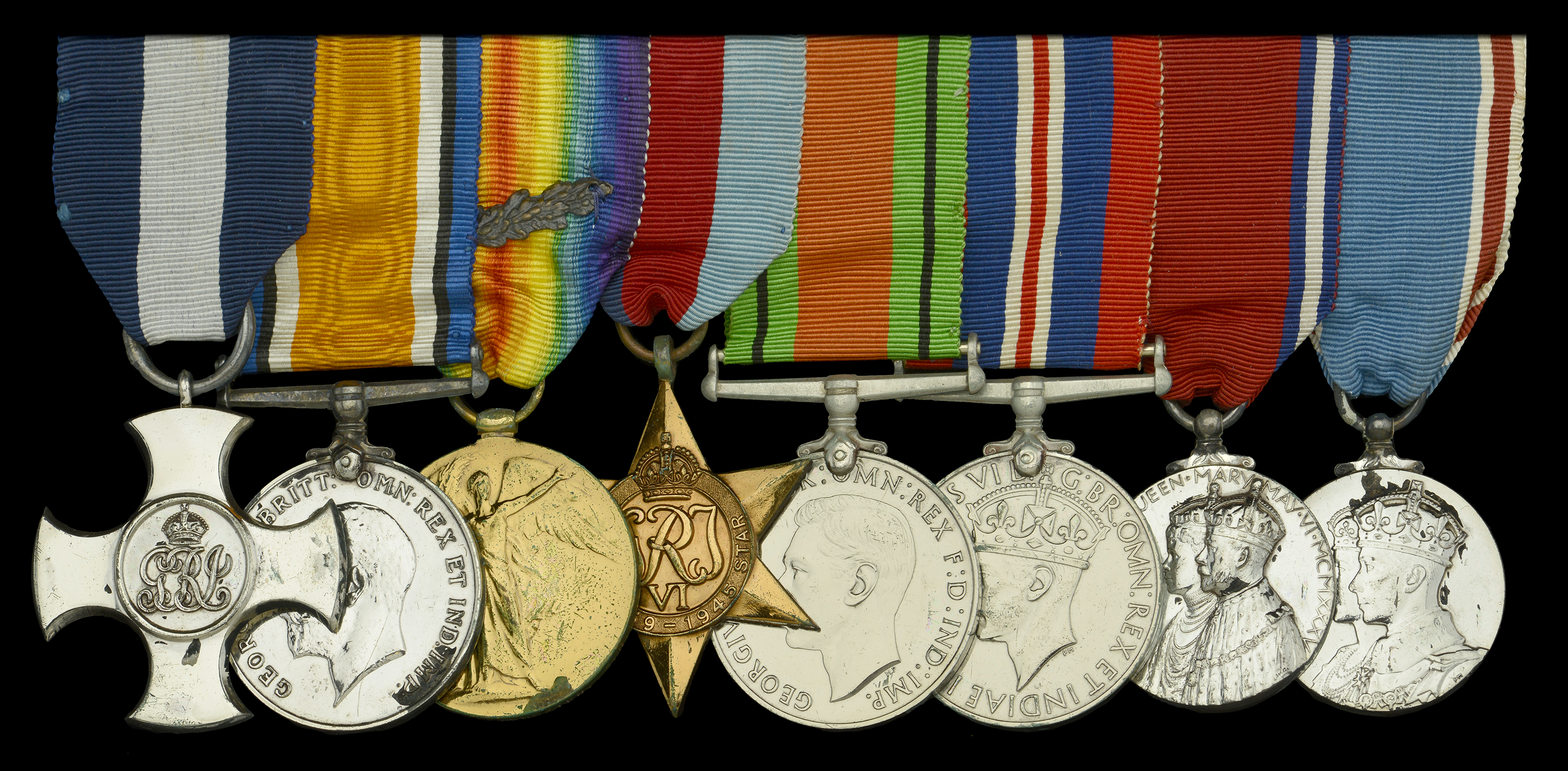The rare Great War Tigris gunboat operations D.S.C. group of eight awarded to Surgeon Captain J. P. Shorten, Royal Navy, who was decorated for treating wounded under very heavy fire in H.M.S. Mantis in February 1917 Distinguished Service Cross, G.V.R., the reverse hallmarked London 1918; British War and Victory Medals, with M.I.D. oak leaves (Surg. Lt. J. P. Shorten. R.N.); 1939-45 Star; Defence and War Medals 1939-45; Jubilee 1935; Coronation 1937, mounted as worn, very fine or better (8) £1,000-£1,400 --- Importation Duty This lot is subject to importation duty of 5% on the hammer price unless exported outside the UK --- --- Provenance: Glendining’s, November 1999. D.S.C. London Gazette 21 September 1917. The original recommendation states: ‘He continued to dress and attend to the wounded in the open while under very heavy fire.’ James Percy Shorten was born in Co. Cork, Ireland on 30 May 1888, the son of a country doctor, and himself qualified in medicine in 1910. Entering the Royal Navy as a Surgeon Lieutenant in the lead up to the Great War, he served in the Harwich Force prior to transferring to the river gunboat Mantis in Mesopotamia in September 1916. The Mantis was actively employed on the River Tigris for much of the Great War, not least at the time of the famous siege of Kut, when she was charged with taking in supplies and trying to break the Turkish grip on the town. But it was for Mantis’s subsequent part in the advance on Baghdad, and the recapture of Kut, on 24-26 February 1917, that Shorten was awarded his D.S.C., treating as he did her wounded under a heavy fire. He was also mentioned in despatches (London Gazette 7 August 1918, refers). Admiral Wemyss’ Tigris despatch for December 1916-March 1917 describes the events of 24-26 February 1917 in detail, the following extract covering the actions of Mantis and her consorts immediately following the fall of Baghdad: ‘The Turks retreating on the left bank were becoming more numerous; they now had our cavalry division in pursuit of them on their right flank and the gunboats on their left. The enemy were firing at us from three directions, and on approaching Nahr Kellak bend I observed a large body of enemy on the left bank at the head of the loop in the river, and gave orders for all guns to be fired on them. They proved to be a strong rearguard, and opened on us with field and machine-guns and heavy rifle fire. At this close range there were casualties in all ships, who were all hit many times, but our guns must have caused immense damage to the enemy, as we were at one time firing six-inch guns into them at about 400 to 500 yards. Besides the Turkish Artillery there were a large number of enemy with rifles and machine-guns behind the bend at a range of about 100 yards from the ships. In the act of turning round the bend shot came from all directions, and casualties of Moth, which came last in the line, were particularly severe. There were casualties in all three ships, Moth, which was magnificently handled by Lieutenant-Commander Charles H. A. Cartwright, who was himself wounded, had three officers wounded - all severely - out of four, and two men killed and eighteen wounded, which is about 50 per cent, of her complement. She was hit eight times by shell - one from ahead hit the fore side of stokehold casing, burst, and pierced the port boiler, both front and back, but luckily missed the boiler tubes. The after compartment was holed below the water line, and the upper deck and funnels of all ships riddled with bullets. The quartermaster and pilot in the conning tower of H.M.S. Mantis were killed, but the prompt action of her Captain saved her from running ashore. I consider that the excellent spirit of the men and skilful handling of the ships by their Captains in a difficult and unknown shallow river were most praiseworthy. We thus passed the enemy rearguard, and large numbers of the retreating Turkish Army were on our starboard beam. I opened rapid fire from all guns that would hear (this included heavy and light guns, pom-poms, maxims, and rifles), and at this short range we did enormous execution, the enemy being too demoralised to reply, except in a very few cases … I have the honour to submit the following for special mention, promotion, honours or awards: H.M.S. Mantis Commander Bernard Buxton, R.N. For good work done on all occasions. His prompt action under heavy fire on 26th March saved H.M.S. Mantis from running aground in a critical position. Surgeon James P. Shorten, R.N. Continued to dress and attend to the wounded in the open while under very heavy fire.’ After the war Shorten served in various naval hospitals, specialising in general surgery and ophthalmology. Among other appointments he was Principal Medical Officer to the battleships Emperor of India and Revenge. And during the Second World War he was Surgeon Captain at a Royal Naval Auxiliary Hospital at Newton Abbot and later at a naval training establishment in Great Malvern. Retiring after the war, he settled at Newton Abbot, where he continued the practice of ophthalmology and spent his spare time working in his garden. He died in February 1978, his obituary in the British Medical Association Journal stating that he was ‘a good shot, a keen fisherman, and a first-class golfer. In 1929 he was the Dorset County golf champion.’





